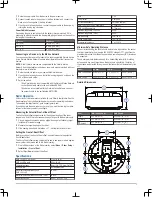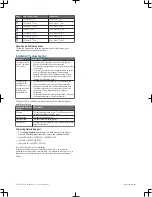
• The device should be mounted at least 1 m (40 in.) away from cables
carrying radio signals such as VHF radios, cables, and antennas.
For Single Side Band (SSB) radios, increase the distance to 2 m (6 ½ ft.).
Mounting the Radar
Before you mount the radar, you must review the mounting location
considerations and select a mounting location.
NOTE: The supplied M8 x 1.25 x 60 threaded rods can be used on mounting
thicknesses of 5 to 30 mm (
3
/
16
to 1
3
/
16
in.) (recommended). For surfaces over
30 mm (1
3
/
16
in.), use longer threaded rods.
1
If you are not installing the device on a pre-drilled Garmin-compatible radar
mount, use the included mounting template to drill four 9.5 mm (
3
/
8
in.)
mounting holes.
2
Install the locking ring and o-ring on the end of the Garmin Marine Network
cable.
3
Connect the power cable to the power port and the network cable to the
network port .
4
Press the cables into any of the guide grooves on the bottom of the
case, and secure them using a cable hold-down plate .
The cables should be bent or twisted as little as possible.
5
Position the radome on the mounting surface with the triangular mark on
the case aligned to the front of the vessel.
6
Apply the included anti-seize compound to the threads of the four
M8 x 1.25 x 60 threaded rods.
7
Insert the four threaded rods into the mounting holes on the bottom of the
radome.
Up to 50 mm (2 in.) of the threaded rods may extend below the radome.
8
Apply a bead of marine sealant on the mounting surface around each
mounting hole.
9
Fasten the radome to the mounting surface using the threaded rods
, flat washers , spring washers , and hex nuts .
10
Using a torque wrench, tighten the nuts from 13.7 to 18.6 N-m (10 to
14 lbf-in.) of force.
Cable Considerations
It may be necessary to drill 32 mm (1
1
/
4
) in. holes for routing the power or
network cables.
• When routing both the power and network cables through the same hole,
you must route the network cable before the power cable.
• You must apply marine sealant to the hole after the cables are in place to
ensure a waterproof seal.
If the routing hole must be made in a visible location, decorative cable
grommets can be purchased from Garmin or a Garmin dealer (optional).
• If needed, the grommet can be trimmed to enable you to route both the
network and the power cable through the same hole.
• The optional grommet does NOT provide a waterproof seal. You must
apply marine sealant to the grommet after the cables are in place to ensure
a waterproof seal.
When installing the network and power cables, you should observe these
considerations.
• Cutting the Garmin Marine Network cable is not recommended, but a field
install kit can be purchased from Garmin or a Garmin dealer if cutting the
network cable is necessary.
• To ensure safety, appropriate tie-wraps, fasteners, and sealant should be
used to secure the cable along the route and through any bulkheads or the
deck.
• Cables should not be run near moving objects and high-heat sources or
through doorways and bilges.
• To avoid interference with other equipment, network and power cables
should not be run next to or parallel to other cables, such as radio antenna
lines or power cables. If this is not possible, the cables should be shielded
with metal conduit or a form of EMI shielding.
• The power cable should be installed as close to the battery source as
possible.
◦ If it is necessary to extend the power cable, the appropriate gauge of
wire must be used (Power Cable Extensions, page 3).
◦ Incorrectly extended runs of cable may cause the radar to malfunction
due to insufficient power transmission.
Connecting the Power Cable
WARNING
When connecting the power cable, do not remove the in-line fuse holder. To
prevent the possibility of injury or product damage caused by fire or
overheating, the appropriate fuse must be in place as indicated in the product
specifications. In addition, connecting the power cable without the appropriate
fuse in place voids the product warranty.
2





















